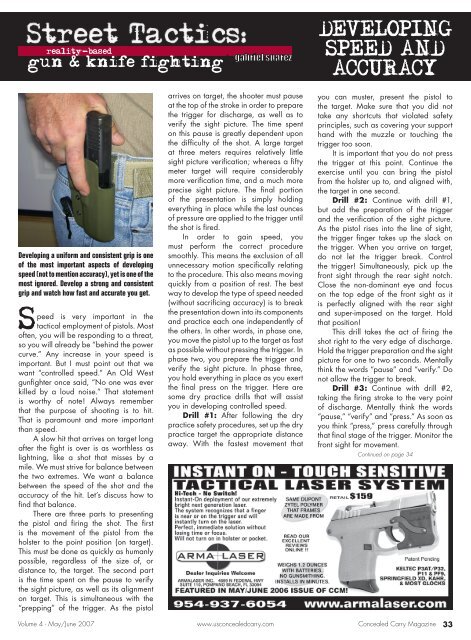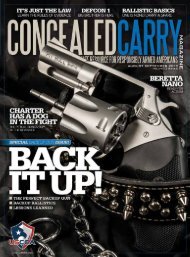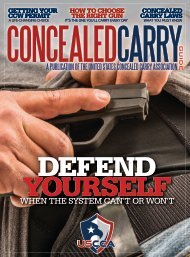of that information to be a responsibleguardian of the information.” There is nodoubt in my mind that The Roanoke Timeswas NOT a responsible guardian of theinformation and that what they did wasmalicious and mean spirited.The “Times” claimed that they pulled thelist down after they were made awarethat some of the names on the list weremade public in violation of Virginia law.They then attempted to blame the VirginiaState Police for not redacting the namesthat shouldn’t have been on the list. Hasthere been any feedback from the statepolice regarding this incident?We have not been contacted bythe state police about this. However,The Roanoke Times is attempting to shiftthe blame to the VSP for the paper’sirresponsible actions. That’s a lot likeblaming the gun instead of the criminal.Of course you and I both know that thislist has exposed the names of employees,those under protective court orders, andlaw enforcement officials, among manyother good people. To your knowledge,has any harm come to the folks whosenames were made public?One parole officer contacted me andsaid that three parolees have shown up athis house this week! Each one admittedthat he got the officer’s address from thatdatabase. One of those parolees showedup at his door while he was at work andjust his wife and child were at home. Afew days after that list came out, anothergun owner (who had a collection of over200 guns) was found murdered in hishome. A connection? We don’t know yet,but that is very, very suspicious.<strong>This</strong> was a personal issue for me, as Igraduated from college in the New RiverValley. I have family residing in Virginiaand spent many years as a resident ofVirginia. I have many friends who hadtheir privacy invaded as a result of theirresponsibility of Mr. Trejbal and theRoanoke Times, but there is more to thisthan a personal vendetta. <strong>This</strong> story hasnational implications for ALL gun owners.For example, can you tell us why thisincident matters to someone living inKansas, Florida or Arizona?Sure. The anti-gun press is alwayslooking for an angle to poke gun ownersin the eye. If The Roanoke Times hadsucceeded in keeping that databaseonline, then other papers would havebeen encouraged to pull the same trick intheir state. The onslaught of angered gunowners here in Virginia might deter otherpapers, but there is no guarantee.As a final thought, it appears that Mr.Trejbal and “The Roanoke Times” bit offa little more than they were willing tochew with their despicable decision andunderhanded scheme to expose theirlaw-abiding neighbors to every criminalelement not only in Virginia, but in theentire nation. After feeling the wrath ofgun owners nationwide, do you thinkthey regret their decision?Oh, you bet they do! While newspaperslike controversy, as it sellsmore papers, this was in a differentcategory. People were furious at thepaper itself, and in huge numbers. Onone of The Roanoke Times’ own polls,98% of respondents were against whatthe paper did! In the hundreds andhundreds of emails the paper printedin response to that article, I didn’t seea single one saying that the paper didthe right thing. Papers are struggling inthe age of the internet and can ill affordthis kind of massive disapproval oftheir actions.**********My heartfelt thanks to Phil for histime, which has been well spent withFox News, numerous local papers andnational publications, as well as a recentappearance on CNN with Paula Zahn todiscuss this very issue.Needless to say, The RoanokeTimes pulled the list within 2 days ofits publication, claiming that they weretrying to verify information containedon the list from the Virginia State Police.The Roanoke Times has since issued anapology for its shoddy handling of suchsensitive data, albeit a weak one, butan apology nonetheless. Hopefully, TheRoanoke Times has learned a valuablelesson, one that I hope all politiciansrunning in 2008 were paying closeattention to as well: that we as gunowners will not sit idly by and be takenadvantage of simply because we aregun owners. We must remember that theenemies of freedom will use whateverdirty, underhanded schemes that areat their disposal, and it remains ourresponsibility to remain vigilant. TheVCDL is not lying down on this, andduring subsequent conversations withMr. Van Cleave, he has assured me thatthey will relentlessly pursue this until theyare satisfied with the results, rather thanwhen The Roanoke Times decides that itshould go away.Mr. Trejbal and the staff at the Timeswill never understand that what theyhave done is wrong. For all of their elitistsmugness and (like most ideologues),they can not see past their own agendas,but when we rose to the occasion as onevoice, they knew that we meant business.As Mr. Van Cleave said to me during oneof our phone calls, “Imagine what wecould accomplish together if we reactedlike this during every election cycle.”Something tells me that we’re going tofind out in 2008!The Virginia Citizens Defense Leaguecan be reached at www.vcdl.org.**********Subsequent to this column beingwritten, the nation’s deadliest massmurder occurred at the Virginia TechCampus in the heart of the new RiverValley of Virginia…Literally down thestreet from Mr. Trejbal. I have reviewedThe Roanoke Times editorial coverageduring the two days since the shootingsand the two days before this columnwent to print. I am quite relieved to seethat the paper’s editorial coverage hasactually been fair during the 48 hourssince this murderous, whack-job tookso many lives. I will continue to monitorthe Times’ editorials and report at alater date.I ask all of you to support the VCDLright now as Mr. VanCleave and hisorganization will no doubt be fighting anonslaught of knee-jerk reaction directedat law-abiding Virginians.My deepest prayers and thoughtsgo out to the families and victimsof the Virginia Tech tragedy.Mark is the director of Gun SafetyEducation and a NRA Certified Instructorin three disciplines. He is the owner of45 Caliber Transfer, LLC and 45 CaliberTransportation, Inc as well as a SecondAmendment activist in his home town.Mark is a member of the ProfessionalOutdoor Media Association (POMA) andthe National Shooting Sports Foundation(NSSF). He encourages readers tocontact him at:theordinaryguy@comcast.net32 <strong>Concealed</strong> <strong>Carry</strong> Magazine www.usconcealedcarry.comVolume 4 - May/June 2007
Developing a uniform and consistent grip is oneof the most important aspects of developingspeed (not to mention accuracy), yet is one of themost ignored. Develop a strong and consistentgrip and watch how fast and accurate you get.peed is very important in thetactical employment of pistols. Mostoften, you will be responding to a threat,so you will already be “behind the powercurve.” Any increase in your speed isimportant. But I must point out that wewant “controlled speed.” An Old Westgunfighter once said, “No one was everkilled by a loud noise.” That statementis worthy of note! Always rememberthat the purpose of shooting is to hit.That is paramount and more importantthan speed.A slow hit that arrives on target longafter the fight is over is as worthless aslightning, like a shot that misses by amile. We must strive for balance betweenthe two extremes. We want a balancebetween the speed of the shot and theaccuracy of the hit. Let’s discuss how tofind that balance.There are three parts to presentingthe pistol and firing the shot. The firstis the movement of the pistol from theholster to the point position (on target).<strong>This</strong> must be done as quickly as humanlypossible, regardless of the size of, ordistance to, the target. The second partis the time spent on the pause to verifythe sight picture, as well as its alignmenton target. <strong>This</strong> is simultaneous with the“prepping” of the trigger. As the pistolarrives on target, the shooter must pauseat the top of the stroke in order to preparethe trigger for discharge, as well as toverify the sight picture. The time spenton this pause is greatly dependent uponthe difficulty of the shot. A large targetat three meters requires relatively littlesight picture verification; whereas a fiftymeter target will require considerablymore verification time, and a much moreprecise sight picture. The final portionof the presentation is simply holdingeverything in place while the last ouncesof pressure are applied to the trigger untilthe shot is fired.In order to gain speed, youmust perform the correct proceduresmoothly. <strong>This</strong> means the exclusion of allunnecessary motion specifically relatingto the procedure. <strong>This</strong> also means movingquickly from a position of rest. The bestway to develop the type of speed needed(without sacrificing accuracy) is to breakthe presentation down into its componentsand practice each one independently ofthe others. In other words, in phase one,you move the pistol up to the target as fastas possible without pressing the trigger. Inphase two, you prepare the trigger andverify the sight picture. In phase three,you hold everything in place as you exertthe final press on the trigger. Here aresome dry practice drills that will assistyou in developing controlled speed.Drill #1: After following the drypractice safety procedures, set up the drypractice target the appropriate distanceaway. With the fastest movement thatyou can muster, present the pistol tothe target. Make sure that you did nottake any shortcuts that violated safetyprinciples, such as covering your supporthand with the muzzle or touching thetrigger too soon.It is important that you do not pressthe trigger at this point. Continue theexercise until you can bring the pistolfrom the holster up to, and aligned with,the target in one second.Drill #2: Continue with drill #1,but add the preparation of the triggerand the verification of the sight picture.As the pistol rises into the line of sight,the trigger finger takes up the slack onthe trigger. When you arrive on target,do not let the trigger break. Controlthe trigger! Simultaneously, pick up thefront sight through the rear sight notch.Close the non-dominant eye and focuson the top edge of the front sight as itis perfectly aligned with the rear sightand super-imposed on the target. Holdthat position!<strong>This</strong> drill takes the act of firing theshot right to the very edge of discharge.Hold the trigger preparation and the sightpicture for one to two seconds. Mentallythink the words “pause” and “verify.” Donot allow the trigger to break.Drill #3: Continue with drill #2,taking the firing stroke to the very pointof discharge. Mentally think the words“pause,” “verify” and “press.” As soon asyou think “press,” press carefully throughthat final stage of the trigger. Monitor thefront sight for movement.Continued on page 34Volume 4 - May/June 2007 www.usconcealedcarry.com<strong>Concealed</strong> <strong>Carry</strong> Magazine 33
















